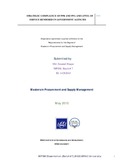Strategic compliance of PPA and PPR and level of service rendered in Government agencies.

View/
Date
2015-05Publisher
BRAC UniversityAuthor
Hoque, Md. EnamulMetadata
Show full item recordAbstract
Bangladesh is vested with a number of problems. Corruption atops the list. In broad brush,
corruption is the abuse of official power for personal gain. Discretionary use of financial
power by the big guns has widened the gap between the poor and the rich. There was no
strong and consolidated guideline for procurement in public sectors. To streamline these
uneven activities an act titled PPA’2006 and PPR’2008 were issued. After that passed 10
years. To make the PEs (Procuring Entities) habituated to using the act and rules properly
Public Procurement Reform project was initiated. Officials from different procurement
agencies have been trained. Many steps have been taken by CPTU (Central Procurement
Technical Unit) to make the use of PPR and PPA popular and easier. We have analyzed a
scenario as to how much compliance the PEs are ensuring while procuring both in terms of
qualitative and quantitative criteria, subjective and objective perspectives. We made
comparative dissection in three different cases namely procurement of goods, works and
service. A study has been conducted how much the act and rules have contributed to
reduce corruption and to increase the level of service.About 8 years have passes since PPA
was enacted. Many departments and organizations are following PPA and PPR. In this
context a study is relevant to analyze the strategic compliance of PPA and PPR in the
procurement practice of different agencies. In strategic point of view, Transparency,
efficiency, accountability, competitiveness, equitable treatment and free & fair
competition are essential to be ensured in the procurement using public funds. The Central
Procurement Technical Unit (CPTU) of the Implementation Monitoring and Evaluation
Division (IMED) is continually monitoring the compliance of PPA 2006 and PPR 2008 by
the target agencies in the light of 45 predetermined Key Performance Indicators (KPI).The
research has been designed to depict the real scenario of how different government
agencies are complying with PPA 2006 and PPR 2008 in their procurement practices. The
main objectives of the study are to find out the extent of compliance of PPR 2008 by the
target agencies as well as other government agencies and to find out the gap of compliance
and scope of improvement for implementation. A questionnaire survey was carried out to
collect primary data from different stakeholders related to procurement activities of
different PEs of different agencies namely RHD, LGED, BWDB, REB, CAAB,DPHE,DC
office. In addition to survey, key informant interviews have been conducted to get the
perceptions of few senior officers of the aforesaid departments and IMED.The study result shows a clear adherence to the rules of PPR 2008 in the target agencies whereas somewhat
less in other agencies in carrying out most of the compliance related KPIs. Among the 20
different compliance issues, it has been revealed that respondents replied in an overall
positive manner as satisfactory against 15 issues especially of the target agencies. .There is
a noteworthy shortfall in case of other agencies. For other 5 issues namely proper
procurement method, proper tender opening and evaluation method, safe custody of
tenders, smooth termination of contract, and absence of professional misconduct are not
satisfactory and a clear improvement is required in these areas. Also, the perceptions of
the respondents regarding the issue of releasing payment need to investigate more
cautiously as there are ambiguity among the findings of present study, individual
consultant’s reports and SRGB’s report. For improvement of these situations, five specific
recommendations have been drawn. These are (i) to induce a mechanism for ensuring safe
custody of received tenders, (ii) to ensure smooth termination of contract, timely payment
to the contractors, tender should be floated only after availability of sufficient fund, (iii)
Adopting proper and justified procurement method (iv) approved guidelines to be
followed in tender opening and evaluation and (v) act and rules regarding professional
misconduct and other offences should be followed strictly. Procurement personnel from
other agencies should also be trained on PPA and PPR.
